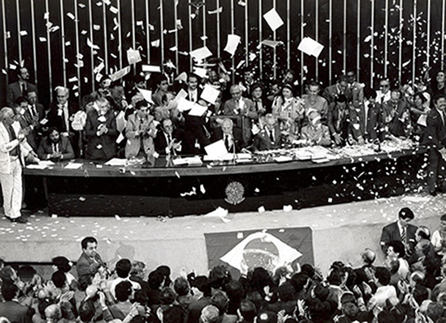Brazil lived under a civil-military dictatorship for 21 years, its end being marked by the indirect election of Tancredo Neves in 1985. As the president-elect died days before his inauguration, Vice President José Sarney assumed the presidency in his place, beginning his term in 1986. It was also in this year that the various progressive political and social forces pressed for the convening of a constituent Assembly, with the election of specific representatives and with full powers to formulate a new constitution for the country.
The main groups opposed to the Assembly were those linked to the previous dictatorial regime, represented by big businessmen and bankers, as well as landowners and the military. Even with pressure, it was not possible to form an Assembly, achieving in the political negotiations the holding of the Congress Constituent Assembly, where deputies elected to the National Congress, in November 1986, would be responsible for drafting the Magna Carta. The difference between the Assembly and the Constituent Congress stems from the fact that those elected for the second would have the commitment to maintain some structures unchanged of the Brazilian State to which they were elected, unlike those elected to the Assembly, who could, in addition to being any citizen, change these structures.
The Constituent Congress was initiated on February 1, 1987 and had as its main group the “Centrão”, formed by deputies and senators from parties such as PMDB, PFL, PDS and PTB. It was formed by 559 congressmen and chaired by Ulisses Guimarães. There were also groups more to the left, such as those linked to the PT and the PDT. The proposals were prepared both by groups of citizens of the country and by groups already organized (such as businessmen and landowners, for example), who through lobbies (a form of economic and political pressure) polarized the debate on important and polemics such as agrarian reform, the duration of elective terms and the structure of the state, the powers assigned to the armed forces, access to education and health etc.

Celebration of the promulgation of the National Constitution in October 1988, in the plenary of the National Congress.*
The debates and votes lasted for 18 months, with the drafting of the text undergoing a series of amendments aimed at materializing the various negotiations carried out. On October 5, 1988 the Constitution of the Federative Republic of Brazil was promulgated, and even with some points ratified and others amended over the years, continues to govern in general terms the social organization and the state Brazilian.
Image source – Brazil Agency
By Tales Pinto
Graduated in History
Source: Brazil School - https://brasilescola.uol.com.br/historiab/constituicao-de-1988.htm

